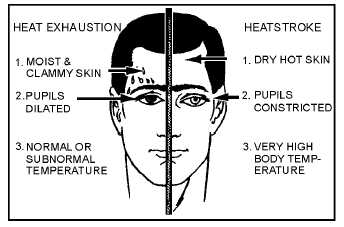1-17
Burn victims require large amounts of water, which should be slightly salted. Because of the nature
of the injury, most burns are sterile. The best treatment for uninfected burns, therefore, is merely to
protect the area by covering it with the cleanest (preferably sterile) dressing available. Never apply
ointments to a burn nor use petrolatum gauze.
Do not attempt to break blisters or to remove shreds of tissue or adhered particles of charred
clothing. Never apply a greasy substance (butter, lard, or petroleum jelly), antiseptic preparations, or
ointments. These may cause further complications and interfere with later treatment by medical
personnel.
Heatstroke
Sunstroke is more accurately called heatstroke since a person does not have to be exposed to the sun
for this condition to develop. It is a less common but far more serious condition than heat exhaustion,
since it carries a 20 percent fatality rate. The main feature of heatstroke is the extremely high body
temperature, 105º F (41º C) or higher, that accompanies it. In heatstroke, the victim has a breakdown of
the sweating mechanism and is unable to eliminate excessive body heat built up while exercising. If the
body temperature rises too high, the brain, kidneys, and liver may be permanently damaged.
Sometimes the victim may have preliminary symptoms, such as headache, nausea, dizziness, or
weakness. Breathing will be deep and rapid at first, later shallow and almost absent. Usually the victim
will be flushed, very dry, and very hot. The pupils will be constricted (pinpoint) and the pulse fast and
strong. Figure 1-10 compares these symptoms with those of heat exhaustion.
Figure 1-10.—Symptoms of heatstroke and heat exhaustion.
When you provide first aid for heatstroke, remember that this is a true life-and-death emergency. The
longer the victim remains overheated, the higher the chances of irreversible body damage or even death
occurring. First aid treatment for heatstroke is designed to reduce body heat.
Reduce body heat immediately by dousing the body with cold water, or applying wet, cold towels to
the whole body. Move the victim to the coolest possible place and remove as much clothing as possible.
Maintain an open airway. Place the victim on his/her back, with the head and shoulders slightly raised. If
cold packs are available, place them under the arms, around the neck, at the ankles, and in the groin.
Expose the victim to a fan or air-conditioner since drafts will promote cooling. Immersing the victim in a
cold water bath is also effective. Give the victim (if conscious) cool water to drink. Do not give any hot



